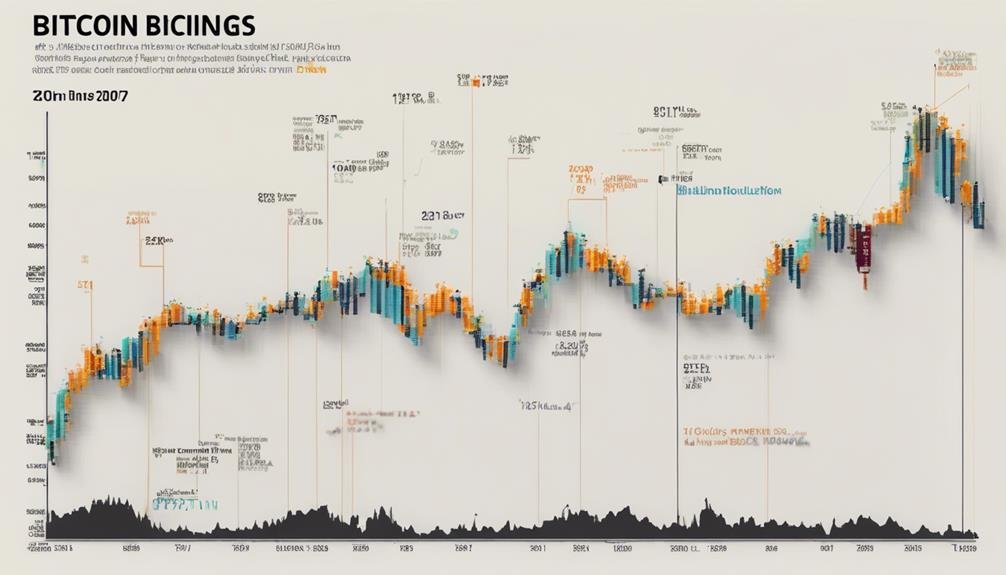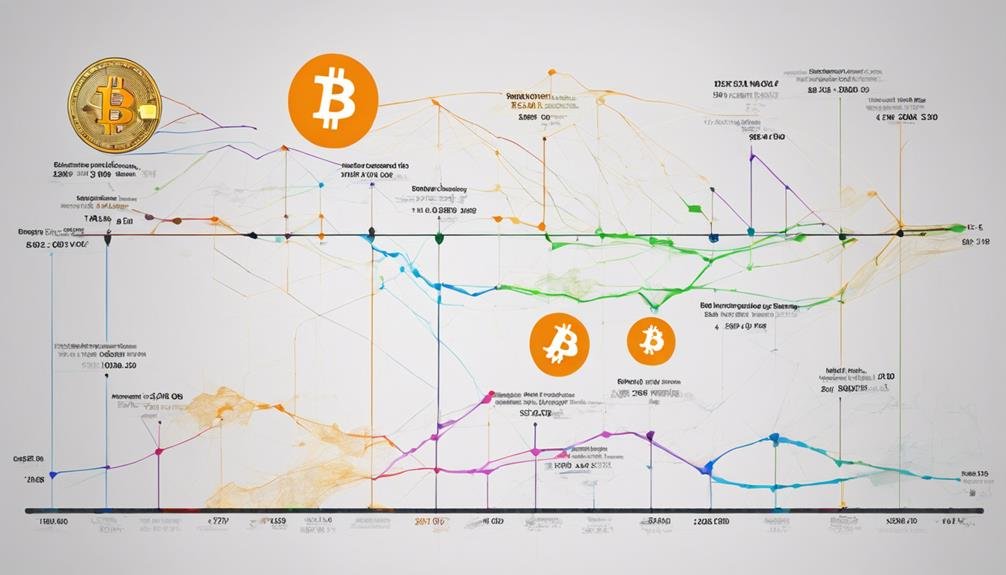Investigating Bitcoin’s price evolution over the past decade is like traversing a complex financial terrain with twists and turns that have intrigued many. The journey of Bitcoin’s value is not merely a chart of numbers but a reflection of a decade filled with economic shifts and technological advancements. Understanding the intricate web of factors that have influenced Bitcoin’s price trajectory can provide valuable insights into its future potential and the broader implications for the financial landscape.
Key Takeaways on Bitcoins Price Evolution: A Decade in Review
- Bitcoin’s price evolution reflects extreme volatility and significant milestones over the past decade.
- Market factors like scarcity, halving events, and institutional adoption heavily influence Bitcoin’s value.
- Historical data suggests potential bullish trends, with a desire for decoupling from traditional markets.
- Geopolitical tensions and energy crises are key drivers impacting Bitcoin’s future price movements.
Historical Bitcoin Price Overview

Bitcoin’s price evolution is a testament to its tumultuous journey, marked by significant milestones and substantial fluctuations. Its historical review reveals a start at a mere $0.0009 in October 2009, a surge to $30 in June 2011, and a subsequent plummet to $5, showcasing the extreme volatility that has characterized its path.
The introduction of Litecoin in late 2011 led to a drastic 90% drawdown in Bitcoin’s price, reflecting the early volatility in the cryptocurrency market. From 2009 to 2012, Bitcoin faced minimal infrastructure and limited adoption during its early years, hindering its widespread acceptance.
However, the landscape changed with the rise of Mt. Gox, a major Bitcoin exchange that by 2014 was handling 70% of Bitcoin transactions, significantly boosting adoption rates. This period also saw Bitcoin’s price surge from [$13] in 2013 to over [$1,000] by November 2013, marking a remarkable price increase and highlighting the growing interest in the digital currency.
The historical evolution of Bitcoin’s price underscores the impact of infrastructure development and adoption on its value over the past decade.
Bitcoin’s Price Trends Analysis

Analyzing Bitcoin’s price trends reveals a complex interplay of market forces and technological advancements that drive its value fluctuations.
Key Insights:
- Market Volatility: Bitcoin’s price history showcases extreme fluctuations, from a high of over $1,200 in 2013 to a low of $111.60 in 2014 due to issues with Mt. Gox, a major Bitcoin exchange at the time. These issues, which included a significant security breach and subsequent bankruptcy, profoundly impacted Bitcoin’s price.
- Halving Impact: The first Bitcoin halving in November 2012, a process that reduces the rate at which new Bitcoins are created by half, saw the cryptocurrency closing the year at [$13.50], hinting at the significant influence of halving events on its value.
- Evolution Over the Years: Despite the ups and downs, Bitcoin has shown resilience, closing 2014 at $318 after a tumultuous year, indicating its growing presence in the financial world.
The analysis of Bitcoin’s price trends underscores the crypto’s maturation in the financial market over the years, with each new year bringing both challenges and opportunities for investors and enthusiasts alike.
Significant Price Milestones of Bitcoin

Examining Bitcoin’s historical price milestones reveals a volatile yet transformative journey from its humble beginnings to significant peaks and valleys in value. Since its inception in 2009, Bitcoin’s price has experienced remarkable fluctuations. From trading at less than a penny to $30 in June 2011, the digital asset plummeted to $2, only to end the year at $4.70.
In November 2012, Bitcoin’s first halving event occurred, culminating in a price of $13.50 by year-end. A significant milestone was achieved in November 2013 when the cost of Bitcoin tripled to over $1,200. However, challenges arose in 2014 when the price dropped to $111.60 following issues with Mt. Gox.
Despite these setbacks, 2017 marked a year of national awareness and substantial price growth as Bitcoin soared to $1,000 early in the year. Bitcoin’s price evolution underscores the impact of various market factors and the significance of halving events within the Bitcoin protocol.
Market Factors Influencing Bitcoin Prices

The interplay of market forces exerts a profound influence on the price movements of Bitcoin, with supply and demand dynamics serving as primary catalysts for valuation shifts. Understanding the market factors that impact Bitcoin prices is essential for investors and enthusiasts alike. Here are crucial elements to take into account:
- Limited Supply: Bitcoin’s capped supply of 21 million coins creates scarcity, driving up its value as demand increases.
- Halving Events: These events, which occur approximately every four years, reduce the rate at which new Bitcoins are created, increasing scarcity and historically leading to price surges.
- Perceived Value and Demand: The perceived value of Bitcoin, influenced by factors like ‘institutional adoption’- the increasing use of Bitcoin by traditional financial institutions like banks and hedge funds—and macroeconomic conditions, impacts demand significantly and, as a result, price fluctuations.
These market factors showcase the intricate web of elements contributing to Bitcoin’s valuation’s ever-changing landscape. Understanding these dynamics as the cryptocurrency market matures becomes increasingly crucial for predicting future price movements.
Forecasting Bitcoin’s Future Price Movements

Bitcoin’s future price movements exhibit a complex interplay of various market factors and external influences, necessitating a strategic approach to accurately predict potential fluctuations. Historical data analysis reveals an average 26% increase in Bitcoin prices during October, a trend that has been observed over the past decade, providing insight for forecasting. Investors are eyeing a possible move towards the [$24,000] mark post-downturns, indicating a bullish sentiment.
Additionally, Bitcoin enthusiasts are increasingly wanting the cryptocurrency to decouple from traditional financial markets in the long term, potentially reshaping its price dynamics. Geopolitical tensions and energy crises also significantly influence Bitcoin’s price movements, highlighting the importance of considering global events in forecasting.
Bitcoin’s journey from being worth less than a penny in October 2009 to its current value is a testament to its potential for substantial price movements in the future. As investors navigate the volatile landscape of cryptocurrencies, understanding these key factors is essential for making informed predictions about Bitcoin’s price evolution, and potentially, reaping significant rewards.
Frequently Asked Questions
How Much Is Bitcoin Expected to Be in 10 Years?
Due to its volatility, you can’t accurately predict Bitcoin’s future price in 10 years. Market trends, regulatory impact, and technological advancements will shape its value. Consider long-term outlook and investment potential while analyzing price predictions.
How Cheap Was Bitcoin 10 Years Ago?
Bitcoin was remarkably cheap ten years ago, allowing early adopters to acquire substantial amounts. Market volatility, regulatory challenges, and investor skepticism were prevalent factors. Despite these, technological advancements, security concerns, institutional interest, and global adoption have influenced its price evolution.
What Is the Historical Peak Price of Bitcoin?
At its historical peak performance, Bitcoin’s price soared to astronomical heights, reflecting market trends and investor sentiment. Price fluctuations, trading volume, regulatory impact, and technological advancements influenced its trajectory, leading to global acceptance and institutional adoption. Bitcoin’s all-time high is $73,738.00 and was reached on March 14, 2024
How Much Has Bitcoin’s Value Grown Since 2014?
Since 2014, Bitcoin’s value has surged exponentially, showcasing market trends favoring its growth. With high investment potential, price volatility remains a crucial factor. Global acceptance, regulatory developments, and technological advancements influence investor sentiment.
Conclusion
To wrap up, Bitcoin’s price evolution over the past decade has been nothing short of a rollercoaster ride. From humble beginnings to astronomical highs, cryptocurrency has kept investors on their toes.
Predicting Bitcoin’s future price movements remains challenging due to factors like halvings and market demand. Strap in, hold on tight and enjoy the wild ride of the Bitcoin world.










